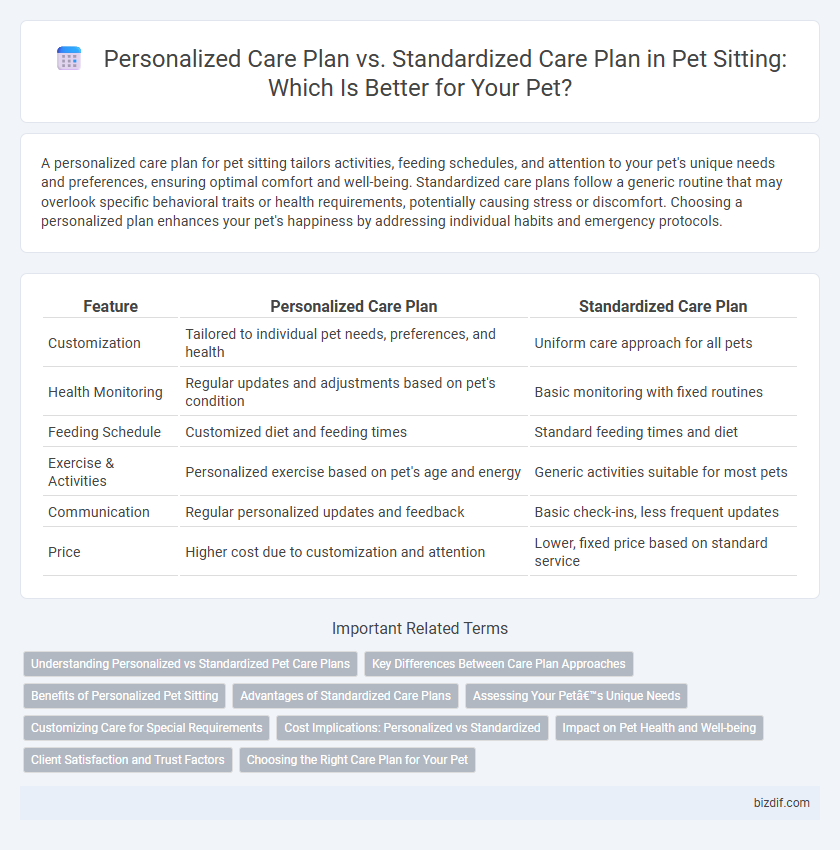A personalized care plan for pet sitting tailors activities, feeding schedules, and attention to your pet's unique needs and preferences, ensuring optimal comfort and well-being. Standardized care plans follow a generic routine that may overlook specific behavioral traits or health requirements, potentially causing stress or discomfort. Choosing a personalized plan enhances your pet's happiness by addressing individual habits and emergency protocols.
Table of Comparison
| Feature | Personalized Care Plan | Standardized Care Plan |
|---|---|---|
| Customization | Tailored to individual pet needs, preferences, and health | Uniform care approach for all pets |
| Health Monitoring | Regular updates and adjustments based on pet's condition | Basic monitoring with fixed routines |
| Feeding Schedule | Customized diet and feeding times | Standard feeding times and diet |
| Exercise & Activities | Personalized exercise based on pet's age and energy | Generic activities suitable for most pets |
| Communication | Regular personalized updates and feedback | Basic check-ins, less frequent updates |
| Price | Higher cost due to customization and attention | Lower, fixed price based on standard service |
Understanding Personalized vs Standardized Pet Care Plans
Personalized pet care plans are tailored to each pet's unique health needs, behaviors, and preferences, ensuring optimal well-being and comfort. Standardized care plans offer a uniform approach, focusing on general care routines but may overlook individual variations in pets' requirements. Understanding these differences helps pet sitters provide more attentive, customized care that promotes pet happiness and health.
Key Differences Between Care Plan Approaches
Personalized care plans in pet sitting tailor services to individual pets' needs, considering factors such as breed, age, behavior, and health conditions for optimal well-being. Standardized care plans follow a uniform approach, offering consistent routines and basic care tasks that suit most pets but may lack customization. The key differences lie in customization level, flexibility, and responsiveness to unique pet requirements versus efficiency and simplicity in care delivery.
Benefits of Personalized Pet Sitting
Personalized pet sitting offers tailored care based on an individual pet's behavior, health needs, and preferences, ensuring optimal comfort and well-being. Customized attention enhances stress reduction and promotes healthier routines compared to standardized care plans, which may overlook unique pet requirements. This approach fosters stronger bonds between pet sitter and animal, resulting in more attentive and responsive care.
Advantages of Standardized Care Plans
Standardized care plans offer consistent, reliable routines tailored to common pet needs, ensuring dependable quality across various sitters. They streamline communication and reduce errors by providing clear, uniform instructions for feeding, exercise, and medication schedules. This approach enhances efficiency, making it ideal for busy pet owners seeking dependable, hassle-free pet sitting services.
Assessing Your Pet’s Unique Needs
Assessing your pet's unique needs is crucial for developing a personalized care plan that addresses their specific health, behavior, and dietary requirements. Unlike standardized care plans, personalized plans consider factors such as age, breed, medical history, and temperament to ensure optimal comfort and well-being. Tailored attention in pet sitting enhances safety, reduces stress, and promotes a happier, healthier pet experience.
Customizing Care for Special Requirements
A personalized care plan in pet sitting tailors services to meet the unique health, dietary, and behavioral needs of each pet, ensuring optimal well-being and comfort. Standardized care plans provide uniform services that may not address specific medical conditions or individual preferences, potentially overlooking essential aspects of a pet's routine. Customizing care for special requirements enhances responsiveness to allergies, medication schedules, and anxiety triggers, resulting in a safer and more nurturing environment for pets.
Cost Implications: Personalized vs Standardized
Personalized care plans for pet sitting typically involve higher costs due to tailored services, specialized attention, and flexible scheduling that address unique pet needs. Standardized care plans offer more predictable pricing with set routines and limited customization, making them more budget-friendly for pet owners. Choosing between the two depends on balancing budget constraints with the value of individualized pet care.
Impact on Pet Health and Well-being
A personalized care plan tailors feeding schedules, exercise routines, and medication management to the individual pet's health needs, significantly enhancing recovery and overall well-being. Standardized care plans offer uniform care that may overlook unique behavioral or medical requirements, potentially limiting optimal health outcomes. Customized attention ensures timely adjustments based on the pet's response, promoting reduced stress, better behavior, and improved quality of life.
Client Satisfaction and Trust Factors
Personalized care plans in pet sitting significantly enhance client satisfaction by addressing the unique needs and behaviors of each pet, fostering trust through tailored attention and responsiveness. Standardized care plans may streamline operations but often fall short in building deep client relationships due to their generic nature. Trust factors are strengthened when pet sitters demonstrate adaptability and empathy, leading to higher retention and positive client reviews.
Choosing the Right Care Plan for Your Pet
Choosing the right care plan for your pet involves evaluating personalized care plans, which tailor services to your pet's unique needs, behavior, and health requirements, against standardized care plans that offer consistent, uniform services. Personalized care plans optimize your pet's comfort and well-being through customized routines, diet, and attention, ensuring better emotional and physical health. Standardized plans may suit pets with routine needs but often lack the flexibility necessary for pets with specific health conditions or behavioral traits.
Personalized care plan vs Standardized care plan Infographic

 bizdif.com
bizdif.com